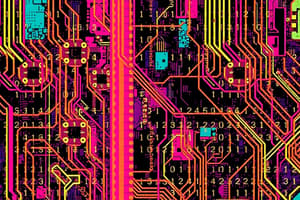Podcast
Questions and Answers
What is the purpose of the instruction 'sub w0, w0, 1' in the assembly code?
What is the purpose of the instruction 'sub w0, w0, 1' in the assembly code?
- To decrement the value of w0 by 1 (correct)
- To set w0 to 0
- To move the value of w0 to another register
- To increment the value of w0 by 1
In the C code provided, what is the correct prototype for the sum function in 'mymain.c'?
In the C code provided, what is the correct prototype for the sum function in 'mymain.c'?
- double sum(int a, int b);
- void sum(int a, int b);
- int sum(int a);
- int sum(int a, int b); (correct)
What assembly instruction is used to allocate space on the stack in the function 'sum'?
What assembly instruction is used to allocate space on the stack in the function 'sum'?
- str w0, [sp, -16]
- stp x29, x30, [sp, -16]! (correct)
- mov x29, sp
- ldp x29, x30, [sp], 16
What is the result of executing the program compiled from the provided C and assembly code?
What is the result of executing the program compiled from the provided C and assembly code?
What is indicated by the 'bl sum' instruction in the assembly code?
What is indicated by the 'bl sum' instruction in the assembly code?
What are the main components of a basic computer system?
What are the main components of a basic computer system?
What is the primary role of the Control Unit (CU) in a CPU?
What is the primary role of the Control Unit (CU) in a CPU?
Which of the following types of numbers can a computer represent internally?
Which of the following types of numbers can a computer represent internally?
What is one common application of assembly language?
What is one common application of assembly language?
What is the main purpose of the fetch-execute cycle in a computer?
What is the main purpose of the fetch-execute cycle in a computer?
Which part of the CPU is responsible for performing arithmetic and logical operations?
Which part of the CPU is responsible for performing arithmetic and logical operations?
Which of the following best describes an embedded system?
Which of the following best describes an embedded system?
In the context of mixed programming, what is a significant benefit of combining assembly code with C code?
In the context of mixed programming, what is a significant benefit of combining assembly code with C code?
What is stored in the register w0 when the main function begins execution?
What is stored in the register w0 when the main function begins execution?
Which command is used to produce relocatable object code from a C source file?
Which command is used to produce relocatable object code from a C source file?
In the assembly code provided, how does the program access the second argument from the command line?
In the assembly code provided, how does the program access the second argument from the command line?
What is the purpose of the 'b.lt top' instruction in the assembly code?
What is the purpose of the 'b.lt top' instruction in the assembly code?
What does the instruction 'ad rp x0, fmt' achieve in the assembly code?
What does the instruction 'ad rp x0, fmt' achieve in the assembly code?
What does the linker do after separate compilation?
What does the linker do after separate compilation?
What is indicated by the '.balign 4' directive in assembly code?
What is indicated by the '.balign 4' directive in assembly code?
How is the function 'myfunc' invoked in the assembly code?
How is the function 'myfunc' invoked in the assembly code?
Flashcards
CPU
CPU
The central processing unit, responsible for executing instructions and controlling data transfer.
Primary memory
Primary memory
The primary memory in a computer, used for storing data and instructions currently being accessed by the CPU.
Secondary memory
Secondary memory
Secondary memory in a computer, used for long-term storage of data and instructions.
Bus
Bus
Signup and view all the flashcards
Control Unit (CU)
Control Unit (CU)
Signup and view all the flashcards
Arithmetic Logic Unit (ALU)
Arithmetic Logic Unit (ALU)
Signup and view all the flashcards
Registers
Registers
Signup and view all the flashcards
Fetch-execute cycle
Fetch-execute cycle
Signup and view all the flashcards
balign 4
balign 4
Signup and view all the flashcards
String
String
Signup and view all the flashcards
Assembly Language
Assembly Language
Signup and view all the flashcards
Assembler
Assembler
Signup and view all the flashcards
Global Symbol (e.g., 'a_m', 'myfunc')
Global Symbol (e.g., 'a_m', 'myfunc')
Signup and view all the flashcards
Directive 'global'
Directive 'global'
Signup and view all the flashcards
Linking
Linking
Signup and view all the flashcards
Function Prototype in Assembly
Function Prototype in Assembly
Signup and view all the flashcards
Calling a Function in ARM Assembly
Calling a Function in ARM Assembly
Signup and view all the flashcards
Argument Passing and Return Values in Assembly
Argument Passing and Return Values in Assembly
Signup and view all the flashcards
Optimizing with Assembly
Optimizing with Assembly
Signup and view all the flashcards
Stack Operations in ARM Assembly
Stack Operations in ARM Assembly
Signup and view all the flashcards
Study Notes
Course Objectives
- Learn how a typical modern computer is structured, i.e., its architecture.
- Focus on CPU architecture.
- Learn computer operation during instruction execution, i.e., the fetch-execute cycle.
- Understand internal data and instruction representation in computers.
- Learn about signed and unsigned integers, characters, strings, and floating-point numbers.
- Learn about machine instructions and assembly language programming for embedded systems, operating systems (OS) kernels, device drivers, and code generators in compilers (though less common today).
- Understand computer architecture and operating systems.
- Learn how to write efficient high-level programs and the connection between high-level and machine-level languages (e.g., C, Assembly).
- Learn to combine assembly and high-level languages.
High-Level Architecture
- A basic computer system comprises a CPU, system clock, and primary memory (RAM).
- Secondary memory (e.g., HDD/SSD) stores data.
- Input/output (I/O) peripherals (e.g., keyboard, monitor) facilitate interaction.
- A bus facilitates communication between components.
CPU
- The CPU is a computer's "brain," executing instructions.
- It manages data transfer through the bus.
- It's usually a microprocessor chip with three main sections: the control unit (CU), arithmetic logic unit (ALU), and registers.
- The CU directs instruction execution.
- The ALU performs arithmetic and logic operations.
- Registers store data during processing.
- Instruction cycles include loading instructions from memory, decoding, acting on appropriate data, storing results.
System Clock
- The system clock is a square wave that synchronizes the CPU and devices.
- It determines a specific speed, and devices time operations based on its frequency (e.g., GHz).
Primary Memory (RAM)
- RAM is used for storing program instructions and data.
- It is accessible by address.
- Data is lost when power is off.
- Usually faster or easier to access data than secondary memory (harddrive, etc.).
Secondary Memory (HDDs/SSDs)
- Used for longer-term storage of computer files (programs and data).
- Data persists even when the power is off.
- Typically slower than primary memory (RAM) but with larger storage capacity.
Buses
- A bus connects components for transferring data.
- Usually divided into address, data, and control buses for addressing locations, sending data, and controlling communications.
Peripheral I/O Devices
- Input devices allow interaction (e.g., keyboard, mouse).
- Output devices present information (e.g., monitor, printer).
Basic CPU Architectures
- SPARC is an example of a load/store machine architecture.
- Typical sequence: Load registers from memory, execute instructions using two registers and store in another, store result in memory.
- Includes RISC and CISC architectures.
RISC (Reduced Instruction Set Computer)
- Uses simple instructions that execute in a single cycle.
- Faster clock rate.
- Larger program size.
CISC (Complex Instruction Set Computer)
- Uses more complex instructions that take multiple cycles.
- Slower clock rate.
- Smaller program size.
Instruction Cycle
- The fetch-decode-execute cycle describes how CPU executes each instruction.
Assembly Language Programs
- A series of statements equivalent to machine instructions.
- An example:
add x20, x20, x21. - Each statement includes an opcode and operands.
- Instructions are stored in sequential memory locations.
- Labels are optional prefixes to statements, representing memory addresses.
Macro Preprocessors
- Used for code reusability, creating macros to replace repetitive blocks of code.
- This makes code more readable and maintainable.
ARM CPU Architectures (Cont.)
- Uses A64 instruction set and 64-bit registers for more common tasks given that it's architecture uses more bits.
ARM Registers
- Usually 64 bit wide, although some are only 32 bits.
- Registers have specific roles (e.g., x0-x7 are used to pass arguments).
- Several special-purpose registers exist (e.g., stack pointer).
- Some registers are "callee-saved" (x19-28). These need to be preserved before call to a function, and restored.
ARM Assembly language
- Instructions for ARM processors.
- Opcodes, operands, and comments are often organized into columns in assembly language programs, along with labels.
Branches and Condition Codes
- A branch instruction changes the flow of instruction execution.
- Instruction result conditions are stored as flags, to make decisions about which instructions to execute.
- Eg, jump if result is equal, else continue.
Loops and Conditional Statements
- Structured code blocks are written using conditional branches using logical conditions to change the code flow..
Basic Arithmetic Instructions
- Addition, Subtraction, Multiplication, Division using register and immediate operands.
Bitwise Operators
- AND, OR, XOR, NOT, shifts
- Manipulate individual bits within registers using operations like NOT or shift left.
Data Structures
- Arrays
- One-dimensional: elements stored in consecutive addresses
- Multidimensional: elements stored in memory using a rule-based method
- Structures: collections of fields of different types located contiguously in memory
External Arrays of Pointers
- Pointers to storage structures.
- Useful for storing data with pointers that are easier to manipulate across different locations.
Command Line Arguments
- Arguments passed into a program from the command line.
Separate Compilation and Linking
- Code modules (e.g., .c, .s files) can be separately compiled into object files (e.g., .o files).
- These are linked using
ld(orgcc) to create an executable.
File I/O
- Functions for interacting with external devices or files.
- Functions to open, read, write, and close the files.
- File descriptors: indexes referring to the current files.
Floating-Point Numbers
- A floating point representation provides a means of storing fractional amounts of numbers.
- There exist different types of operations, conversion, comparison or other manipulations for floating point-numbers.
Floating-Point Instructions
- Add, subtract, multiply, divide, absolute -use s registers for single precision, d registers for double precision.
- Compare - set condition flags, followed by conditional branches.
Input and Output
- System calls are used for interacting with external devices or files.
- Using system calls
open,read,write, to access or create files. - Using system call
closeto close files or descriptors.
Subroutines and Stacks
- A subroutine call has special conditions to take into account
- Callee-saved registers, 8 special registers, these need to be pushed on top of the stack before and popped off after a subroutine call operation.
Pointers
- Pointers take in addresses, not values.
- These address locations for storing data may change or be overwritten across different functions or subroutine tasks.
Studying That Suits You
Use AI to generate personalized quizzes and flashcards to suit your learning preferences.




